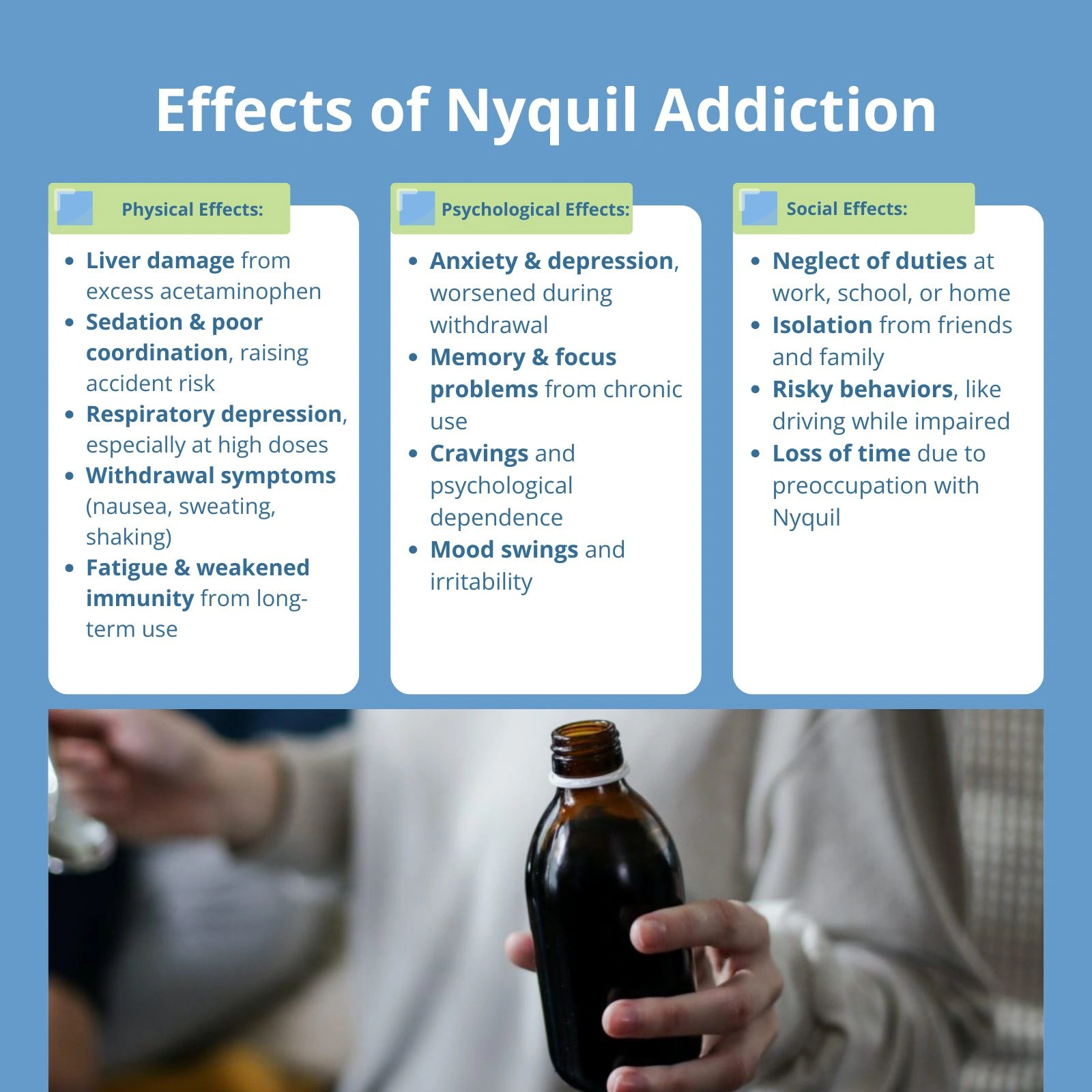
Wait, Did That Just Happen?
If you landed here because you realized—maybe with a sinking stomach—that you accidentally took NyQuil and Tylenol too close together, first… take a breath. Seriously. You’re not alone, and this happens way more often than you’d think. I’ve done it myself, and I’m even a bit obsessive about organizing my medicine cabinet. (Post-it notes, pill containers—the whole nine yards.)
Here’s how it happens: You’re foggy with a cold. You reach for NyQuil at bedtime so you can actually sleep, feeling like a genius for getting ahead of those nasty symptoms. But then—head throbbing or fever still sticking around—you reach again for Tylenol a couple hours later. “It’s a different color, so it must be safe, right?” The next morning, the panic sets in as you start googling.
But Isn’t It Just Cold Medicine?
It’s All About What’s Inside
Here’s where a ton of people (myself included, once) get tripped up. Both NyQuil and Tylenol contain acetaminophen. Tylenol is literally the brand name for it, and NyQuil—depending on the version—can have a pretty hefty dose inside, too.
What’s wild is over 600 different prescription and over-the-counter meds sneak acetaminophen into their ingredient list—painkillers, cold medicines, allergy relief, even some prescription combos.[1] So… unwittingly taking too much? Not hard. It’s less like stepping on a health landmine and more like just missing the sign that says “danger ahead.”
Mini Story Time
You know those random health group chats? My friend Sam told us she’d done this exact combo during last year’s flu season. She took NyQuil for sleep, then Tylenol for her morning headache. By lunchtime, she was feeling queasy, chalked it up to the flu, but panicked when the nausea stuck around. She was fine after some monitoring (and a sheepish call to her doctor), but it totally threw her off.
Why Even Worry?
The Hidden Risk We All Overlook
Here’s the not-so-fun science: your liver is the MVP processing center for these meds. Acetaminophen gets broken down in your liver, and if you overload it? There’s a real risk of liver damage—sometimes even before you feel a thing[3]. It’s sneaky because the initial symptoms of too much acetaminophen look a heck of a lot like having the flu: fatigue, cramping, nausea, loss of appetite, stomach pain, sweating.[1][5]
Some unlucky folks don’t get any warning. Others feel off, then start noticing yellow tints to their skin or eyes (that’s called jaundice, by the way), or upper-right abdominal pain, or just persistent, gnawing queasiness that doesn’t fade.[2][4] If it’s a big overdose, things can get dangerous fast—kidney problems, confusion, and in rare worst-cases, life-threatening situations.[4][6]
How Much Is “Too Much”?
Ready for a little math? (I promise, not hard.) Adults shouldn’t go over 4,000 mg of acetaminophen per day. Some experts say stay even lower—around 3,000 mg to be ultra-safe.[5] NyQuil typically has 650 mg per dose; Tylenol tablets range from 325 mg to 1,000 mg each. See how easy it is to go over? Two doses of NyQuil and a couple Tylenols scattered through the day and you’re tiptoeing past the “safe” zone in sneaky fashion.
Real-Life Table: What’s in Your Dose?
| Product | Typical Acetaminophen Amount | How It Adds Up |
|---|---|---|
| NyQuil (1 dose) | ~650mg | Great for bedtime, but watch for extra pain meds |
| Extra Strength Tylenol (2 tablets) | 1,000mg | Standard adult dose—easy to double up by accident |
| NyQuil + Tylenol | Up to 1,650mg (in one go!) | Can stack to dangerous levels within 24 hours |
Have you ever checked the labels to compare? I bet most of us haven’t, except when desperately searching the medicine cabinet at 2 am…
Ok, I Did It: Now What?
Don’t Spiral. Check the Signs.
First things first—don’t blame yourself, and seriously, don’t panic. Unless you maxed out the dose or have an underlying liver issue, a single episode of doubling up may just mean keeping watch on your body and playing it smarter next time.[3][5]
But do watch for warning symptoms in the next few hours and days. Here’s what’s common:
- Nausea and vomiting that feels “not like a regular cold”
- Abdominal or upper-right belly pain
- Fatigue or feeling “just not right”
- Yellowing of skin or eyes
- Loss of appetite, confusion, or bizarre drowsiness
If you experience any of these, or the dose you took edges near or over the 4,000 mg mark in 24 hours, don’t wait. Make that call—to your doctor, your local poison control (1-800-222-1222), or head to urgent care.[1][3] Early treatment can make a world of difference.
Another Anecdote for You
There was a day in college when I did exactly this: NyQuil at night, Tylenol in the early morning haze before class. Later, I felt downright woozy and debated whether it was my cold or something worse. Turns out, it was a little of both—I’d just overloaded my system. One quick nurse call later (shoutout to campus health!) and a big bottle of water, and I learned my lesson.
Breaking Down the Wait
Gaps Are Good—But How Much?
Here’s where so many people want a clean, magic number: How long to wait to take NyQuil after Tylenol (or vice versa). There’s no “perfect” answer, but most sources and pharmacists suggest waiting at least 4-6 hours between doses to give your liver a fighting chance to metabolize the medication. If your cold is brutal and you want to alternate, ask your pharmacist about safer alternatives like ibuprofen (if your stomach can handle it).
If you’re ever unsure, just Google (or ask!) Can you take NyQuil 2 hours after Tylenol, but know that the short version is: be cautious, and don’t stack medications with the same active ingredient unless a healthcare pro says it’s okay.
Label Obsession = Healthy Habit!
Have you ever noticed how tiny those ingredient lists are? I’m honestly a fan of the flashlight + magnifying glass combo in winter flu season. It feels dorky, but it saved me from double-dosing on more than one occasion. This is your nudge to get a bit label-obsessed, too.
What About Alcohol (Or Other Meds)?
Turns Out, It’s a Triple Whammy
Okay, real talk: Mixing acetaminophen heavy-hitters like NyQuil and Tylenol is rough enough on your liver—add alcohol (or certain antibiotics, antifungals, etc.) and you’re cranking up the odds of trouble. Doctors and experts are pretty blunt about this: just avoid alcohol entirely when you’re taking medicines that have acetaminophen[2][3].
Even more, there’s a string of common drugs (like some antibiotics, antifungals, and certain psychiatric meds) that interact terribly with acetaminophen. If you’re not sure, one quick call to the pharmacist covers your bases.
Smarter Cold Season Strategies
What I Do Differently Now
After my own bad pairing, I did a couple things to smarten up my cabinet:
- I stick a big sticky-note label on combos (“contains acetaminophen!” in neon highlighter…yes, really.)
- I asked my doctor about mixing in ibuprofen for pain relief, alternating with acetaminophen for fever—my stomach is okay with it, but yours might not be, so double check.
- I put a reference chart in the medicine box with “last dose—what, when” so even if you’re groggy, you can double check before swallowing.
Oh, and I check how long to wait to take NyQuil after Tylenol every now and then, just for peace of mind.
Short Table: Meds and Timing
| Combo | Safe Wait Time? | Better Alternative? |
|---|---|---|
| NyQuil + Tylenol | 4-6 hours, minimum | Alternate with ibuprofen if okay’d |
| NyQuil (contains acetaminophen) + any other acetaminophen (cold meds, pain) | Never overlap | Choose only one product at a time |
What do you think about this approach? Maybe you’ve already got a great system — if so, share it. The more we swap strategies, the fewer “oh-no” moments we’ll all have.
Small Steps, Big Difference
You’ve Got This (Really)
So, if you’re in that boat—”I accidentally took NyQuil and Tylenol”—don’t think you’re doomed. For most healthy adults, it’s just a reminder to stay a little sharper next time. If you’re at all concerned, or notice those weird symptoms, call for help. That’s why professionals exist—to help you, not to judge you.
For next time? Take it slow. Write down what you take and when. Ask questions, label bottles, set reminders—whatever it takes so you don’t catch yourself in panic-googling mode at midnight.
If you keep running into questions—like “can you take NyQuil 2 hours after Tylenol?” or “how long to wait to take Nyquil after Tylenol”—ask your doctor, hit up the pharmacist, or pop over to helpful links like can you take Nyquil 2 hours after Tylenol when you need quick guidance. Seriously, there’s no such thing as a silly question when it comes to your health.
Wrap-Up: Take Care of That Liver
Mix-ups happen, friend. You can be super careful and still drop the ball when the world’s spinning with flu fog or headaches. The good news? One accidental double dose usually isn’t a deal-breaker, but it’s a great nudge to pay a little extra attention next time. Don’t mix multiple meds with acetaminophen—check those labels, set reminders, and when in doubt, space things out at least 4-6 hours.
You’ve got the tools, and more importantly, you’ve got the common sense. Trust yourself, take action if you need it, and then—when you’re feeling better—share what you learned with someone else. Sometimes, that “oh no!” moment is all it takes to make cold season a little safer for everyone.
Stay well. And hey… if you’re reading this while curled up with a box of tissues, I hope you get some solid, restful sleep tonight—NyQuil responsibly, of course.


















Leave a Reply
You must be logged in to post a comment.